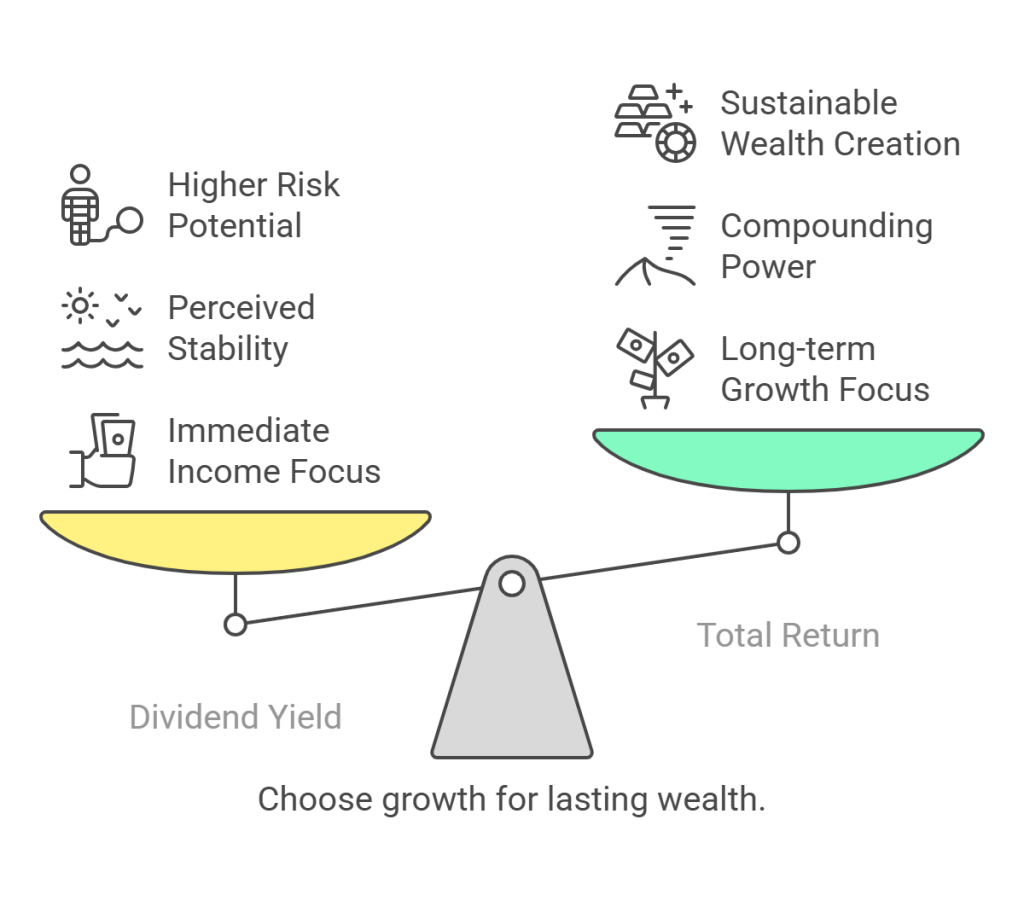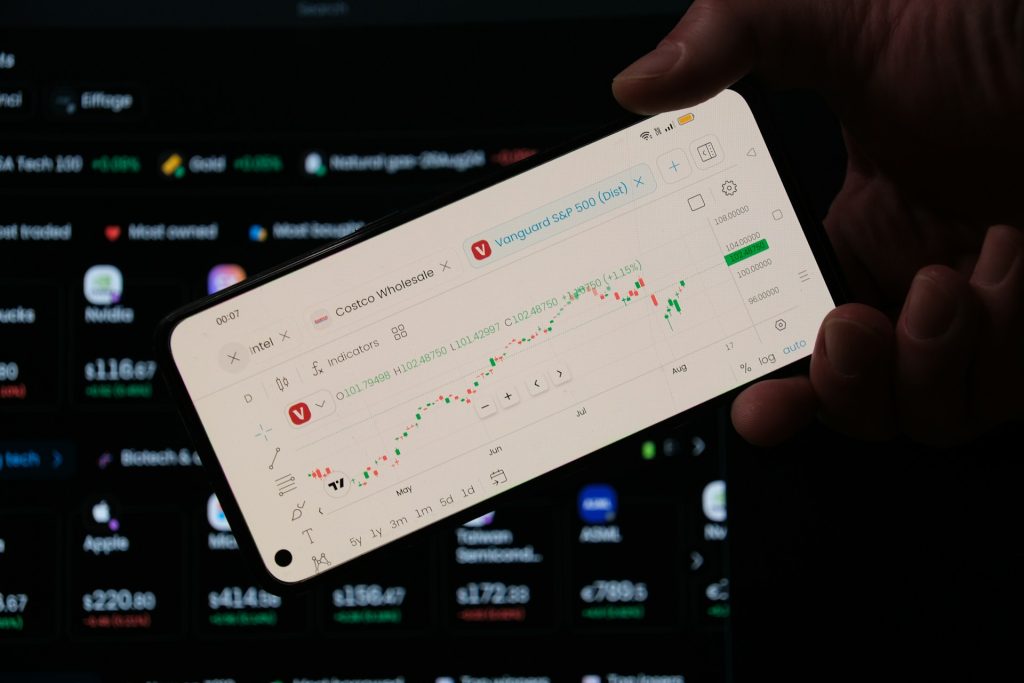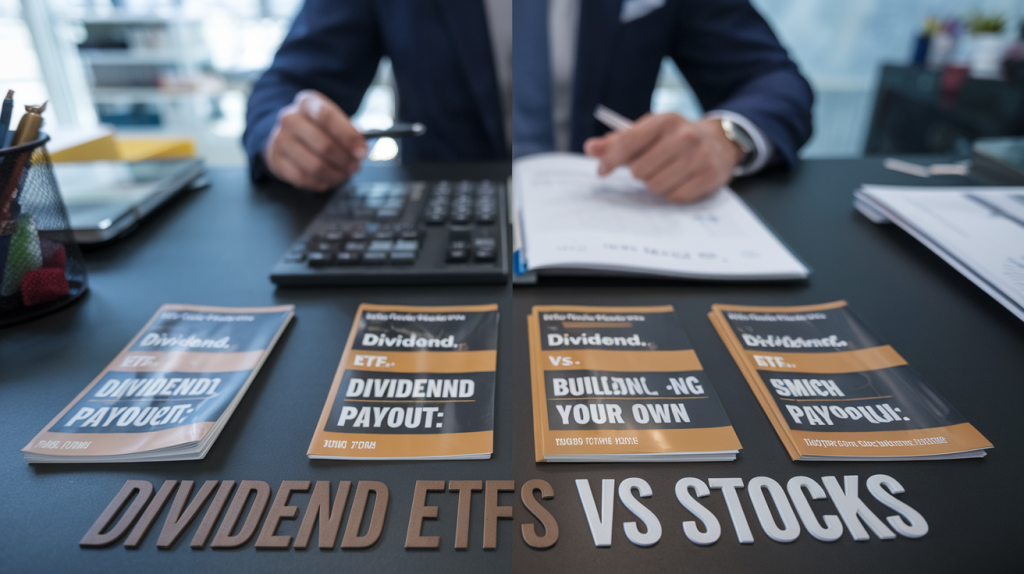
Income investors everywhere are familiar with the siren song of the dividend yield.
Dividend yield offers comfort. It promises passive income and makes a stock feel like a steady paycheck. But if you’re chasing yield without looking at the full picture, you’re likely leaving serious money on the table. In fact, focusing on dividend yield alone could cost you millions over your investing lifetime. In this article, you’ll see why total return, not yield, is the true north for wealth creation, and how to restructure your thinking to avoid this expensive mistake.
Dividend Yield Is Only One Piece of the Puzzle
Dividend yield measures a company’s annual payout relative to its stock price. It’s simple and intuitive, but often misleading. A high yield might catch your eye, but it rarely tells the whole story. For example, if a $50 stock pays a $5 annual dividend, its yield is 10%. Sounds attractive. But what if the company is over-leveraged, facing declining sales, or losing market share? That 10% could be a prelude to a dividend cut, a falling share price, or both.
The danger is in mistaking yield for value. Investors often assume a higher yield means a better bargain. But the market isn’t stupid. If a stock yields 10% while others in the same sector yield 3%, the market is usually pricing in elevated risk.
Why Chasing Yield Can Wreck Your Portfolio
Let’s look at two well-known examples: AT&T and Altria. Both companies have historically offered high dividend yields, attracting income-focused investors. But in exchange for those payouts, shareholders have watched their capital shrink. AT&T cut its dividend in 2022 and spun off WarnerMedia. Altria’s total return over the last decade is meager despite its generous yield—and that’s before factoring in inflation.
Contrast this with a company like Texas Instruments. It yields about 3.6% today, but has raised its dividend for 19 consecutive years, while consistently compounding capital. The stock has more than tripled in 10 years, delivering strong total returns.
If you had chosen Altria 10 years ago for its 6% yield, you’d have earned income but lost real wealth. Choosing Texas Instruments would have given you growing dividends and capital appreciation. Total return is where the money is made.
Total Return: The Real Driver of Long-Term Wealth
Total return is the combination of income and price appreciation. It reflects not just what the company pays you today, but how its value compounds over time. For example, if you invest in a company yielding 2% but growing earnings and dividends 10% a year, you’ll beat a flat 6% yielder within just a few years.
The most powerful force in investing is compounding. Companies that grow earnings at double-digit rates while also paying and increasing dividends create wealth at a much faster pace than those simply maintaining a high yield.
Compounders Win: Why Modest Yields Can Be More Powerful
Microsoft is a classic example. It initiated a dividend in 2003 with a yield barely above 1%. Since then, it has compounded both earnings and dividends, raising its payout every year. The stock has delivered more than a 10x return since 2010. A high yield may give you $6 on a $100 investment, but if that $100 never grows—or worse, shrinks—you’re standing still or losing ground. A company that starts with a $1.50 dividend on a $100 investment and grows it 10% a year ends up paying $3.89 ten years later. And if the stock triples in that time? You’ve won on both ends.
The Emotional Bias Toward Yield
Investors crave certainty. Dividend income feels like money in the bank. That predictability leads to overconfidence in income stocks, even when fundamentals are weak. Yield addiction is common, particularly among retirees. But predictable income from a melting ice cube is still capital destruction—just on a delay.
Many high-yielding stocks are structured more to appeal to this bias than to create long-term value. You see this in Business Development Companies (BDCs) and Mortgage REITs, which often pay out more than they earn and use leverage to prop up yields. These products can work in narrow windows but rarely reward long-term holders.
Retirees Are Most at Risk of This Mistake
If you’re living off portfolio income, it makes sense to prioritize yield—but only if it’s sustainable. The goal isn’t to reach for the highest possible income today. It’s to build a durable portfolio that supports your lifestyle for decades. High-yield stocks with declining business models might meet your income target now but leave you with a depleted nest egg later.
A better approach is to use a mix of dividend growth stocks, modest-yield compounders, and even selective bond ladders or annuities. The combination gives you current income plus future growth to combat inflation.
The Right Way to Use Dividend Yield
Dividend yield is not useless. It can be a useful signal, especially when combined with other factors. A rising yield caused by a falling stock price might indicate a bargain—or a value trap. The difference lies in cash flow, earnings quality, and payout sustainability.
If a company pays out 60% of its free cash flow and has rising revenues, improving margins, and a growing market, its 4% yield might be underpriced. On the other hand, if a company pays out 110% of its free cash flow to maintain a 9% yield, you should run.
Dividend Growth Trumps Dividend Yield
Dividend growth is a far better signal of business health than static yield. Companies that can raise their dividends every year are usually generating strong free cash flow and reinvesting profitably. A 2% yielder growing dividends at 10% per year will surpass a stagnant 6% yielder in both income and capital gains within a decade.
Look at the Dividend Aristocrats. These companies have raised dividends for 25+ consecutive years and include businesses like Johnson & Johnson, Procter & Gamble, and Lowe’s. Their yields are modest, but their returns are anything but.

Case Study: The Yield Trap vs. The Compounder
Let’s revisit AT&T and compare it to Lowe’s. Over the last 10 years, AT&T’s total return has been about 122%, which is a slow double in 10 years. Its dividend was attractive, but its strategic blunders and lack of growth dragged everything else down. Meanwhile, Lowe’s started with a modest yield, grew its dividend at a double-digit rate annually, and delivered 246%+ in total return.
These results are not anomalies. They’re the rule when you switch your thinking from “What does it pay me today?” to “What can this business become tomorrow?”
How to Audit Your Portfolio Right Now
Here’s a quick framework: if your stock stopped paying a dividend, would you still want to own it? If the answer is no, you likely don’t understand the business or don’t believe in its future. That’s a problem.
Shift your analysis to fundamentals. Does the company generate excess free cash flow? Is it growing revenues and earnings? Is the payout ratio reasonable? Is the dividend growing? If so, even a low current yield could be a ticket to long-term wealth.
One quick way to identify attractive dividend growth stocks that can generate strong total return over time is to calculate its Chowder Number.
Conclusion: Don’t Trade Long-Term Wealth for Short-Term Comfort
The allure of dividend yield is understandable—but often dangerous. Wealth is built through total return, not income alone. Yield without growth is a mirage. Instead of chasing payouts, focus on businesses with the ability to grow, compound, and reward you for years to come. That’s how you turn a $500,000 portfolio into $2 million without taking undue risks.
In the end, dividends are a tool. But total return is the goal. Don’t settle for short-term comfort. Build long-term freedom.

Shailesh Kumar, MBA is the founder of Astute Investor’s Calculus, where he shares high-conviction small-cap value ideas, stock reports, and investing strategies.
His work has been featured in the New York Times and profiled on Wikipedia. He previously ran Value Stock Guide, one of the earliest value investing platforms online.
Subscribe to the Inner Circle to access premium stock reports and strategy insights.
Featured in:







